2D Workflow Introduction
Table of Contents
This overview will serve as an introduction to the 2D workflow inside of Ventuz Designer. You will learn to work effectively with imported Photoshop (.psd) files and different blending techniques. Throughout this page you will find quick links to more detailed and technical descriptions of relevant topics. We recommend reading trough these as well, even if you are a more advanced Ventuz user.
Introduction
After reading through this introductory guide, you should have an understanding of the most common 2D workflow use cases. We will cover topics such as: where to find the different Blending modes, Layer Groups and how to import of Photoshop (.psd) files.
Basics
It is important to understand how the rendering order works inside of the Layer Editor. The bottom layer will always be rendered in front, which is the opposite to how layers work in programs like Photoshop. To access the contents of any layer, you need to click on the  icon next to the layer name. Clicking on the Layer in the Layer Editor will provide you with access to the properties of the selected Layer inside the Property Editor.
icon next to the layer name. Clicking on the Layer in the Layer Editor will provide you with access to the properties of the selected Layer inside the Property Editor.

New 2D layers can be added by pressing the small + in the top left corner of the Layer Editor, and selecting the type of 2D layer you would like to add from the drop-down menu. One of the most commonly used types of 2D layer is an Image Layer. This is a basic 2D Layer that allows you to directly import images into Ventuz and manipulate things like orientation, blending or the mapping of the image.
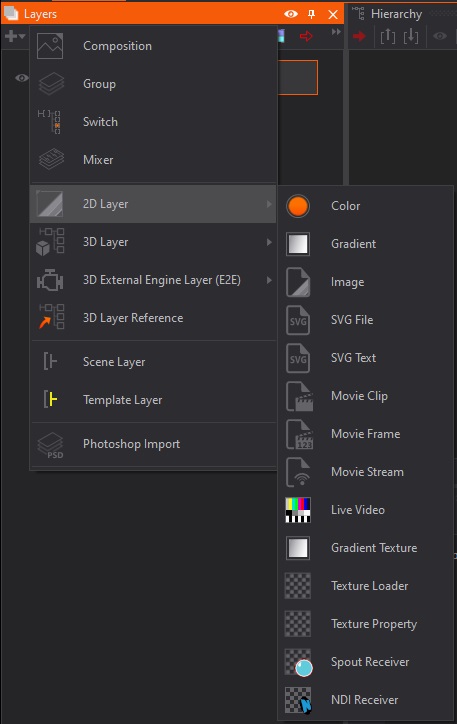
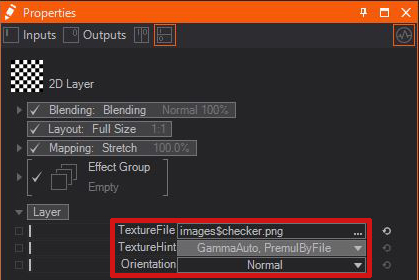
Layer properties can also be accessed inside of the Layer Editor by click the small triangle (next to the  icon). This will expand the properties section for the selected Layer.
icon). This will expand the properties section for the selected Layer.
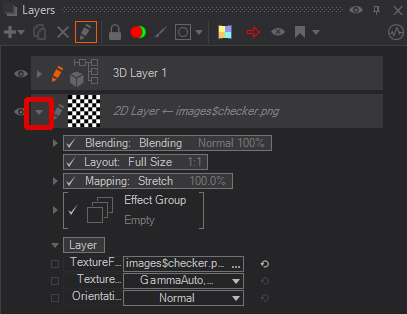
Every 2D Image layer will have a root node inside of it. Accessing this node is done by clicking the  icon for the specific layer, and looking inside of the Content Editor. This root node contains the Texture Loader where additional properties can be edited, predefined images can be selected, or you can change the whole Texture property to something different
icon for the specific layer, and looking inside of the Content Editor. This root node contains the Texture Loader where additional properties can be edited, predefined images can be selected, or you can change the whole Texture property to something different

The Group Layer is a helpful tool when trying to keep things organized. This Layer type can be found at the very top of the list when adding a new Layer.
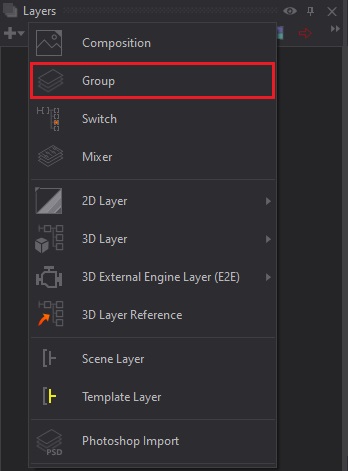
Adding additional Layers to a Group Layer is done by pressing the small triangle to expand the Group Layer properties, and then click dragging the Layer you would like to add into the Group Layer properties area. An orange line will indicate where the selected Layer will be moved to after the mouse button is released.

Photoshop Import
Ventuz supports the direct import of Photoshop (.psd) files. Importing a Photoshop file will maintain its layers as individual Ventuz Layers, as well as preserve the original Transparency and Blending Mode properties for each layer.
To add a new Photoshop Layer, click on the small + on the Layer Editor, and select Photoshop Import from the drop-down menu.

To import a Photoshop file, click the small triangle on the newly added Photoshop Layer to expand its properties. Then, click on the three dots in the Asset field and locate the Photoshop file you would like to add using the Open dialog.
If the imported Photoshop file has multiple layers, they can be found inside of the Photoshop Layer by clicking on the small triangle to expand its properties. Each of these Layers can be modified inside of Ventuz without affecting the original Photoshop file. On import, the Photoshop file is converted to a Ventuz Group Layer.
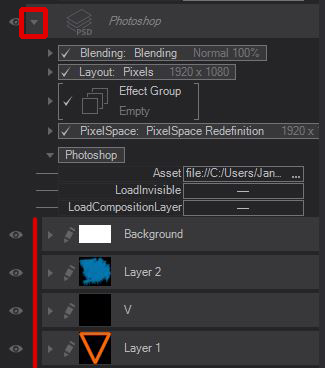
For more information regarding Photoshop Layers please refer to the Photoshop Import documentation.
Blending
The Ventuz Designer has a wide range of different blending modes. You can find the blending modes for each layer in either the Layer Editor or the Property Editor.
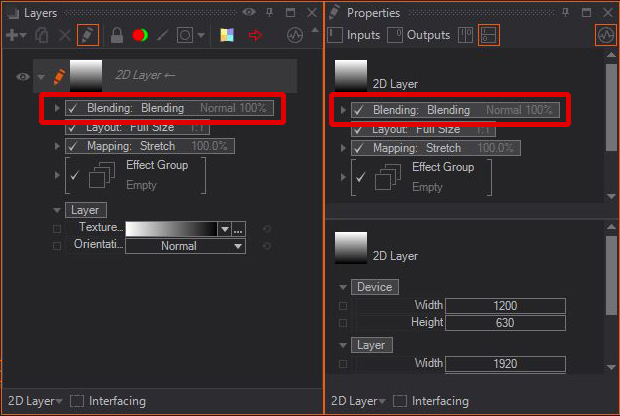
To access the different blending modes, you need to expand the Blending property group by clicking the small triangle next to Blending, and then click the the Mode drop-down menu.
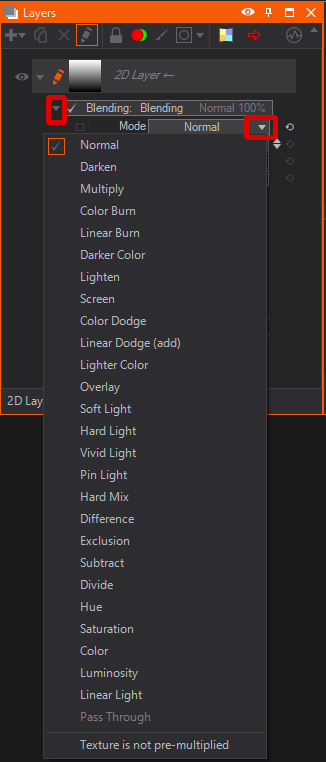
You can blend 3D and/or 2D content with each other using these options. It is also possible to blend complete scenes with each other by using a Scene Layer. A detailed description of the effects from different blending modes can be found here.
Effects
Layer Effects can also be found in the Layer properties. You can access these different Layer Effects by clicking the small triangle to expand the Effect Group properties.
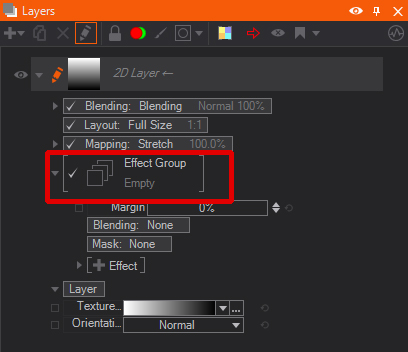
Now you can click the small + to add an effect to the selected layer.
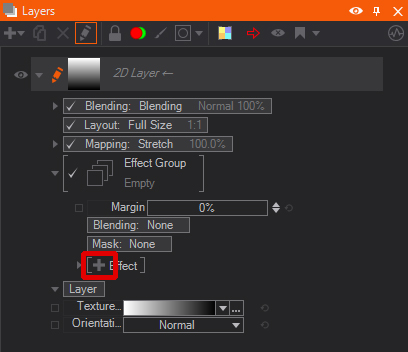
Effects are grouped into different categories. Some of these effects requirement movement on the layer for the effect to be noticable, while others will be immediately visible.
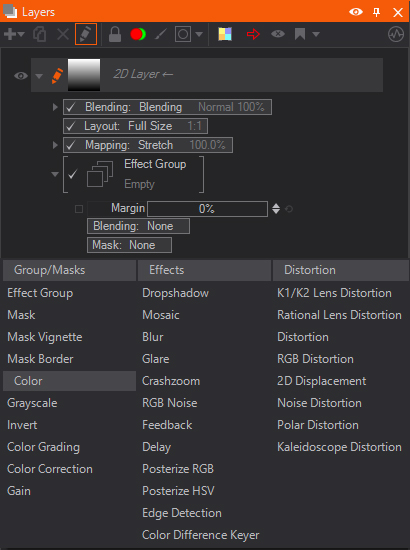
Effects can have a big impact on scene performance, so use them wisely and downscale them whenever possible. Effects can also be applied to a Group Layer (rather than individual layers) which can help improve scene performance.
Conclusion
With this information, you should now be capable of establishing an effective 2D workflow within Ventuz Designer. For more help visit the links below, or join our Discord server to get in touch with our community to get additional help or feedback on your projects.